How to get rid of a mixture of different acne scar types
A laser and acne scar specialist explains

By Ulrik knap, md, laser & acne scar specialist
Treating acne scars is a medical art that requires great skills and the use of the right methods. Not one method fits all acne scar types. Hence, I treat acne scars with different methods and choose the best methods for each individual acne scar. Combining different methods – when relevant – is the only way to achieve the highest cure rate. Therefore, patients come from most of the world to visit my office and have their acne scars treated by me personally.
Boxcar Scars
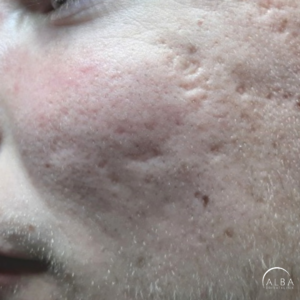
These acne scars are round to oval depressions with sharply demarcated vertical edges, similar to varicella (chickenpox) scars. They are clinically wider at the surface than ice pick scars and do not taper to a point at the base.
Rolling Scars
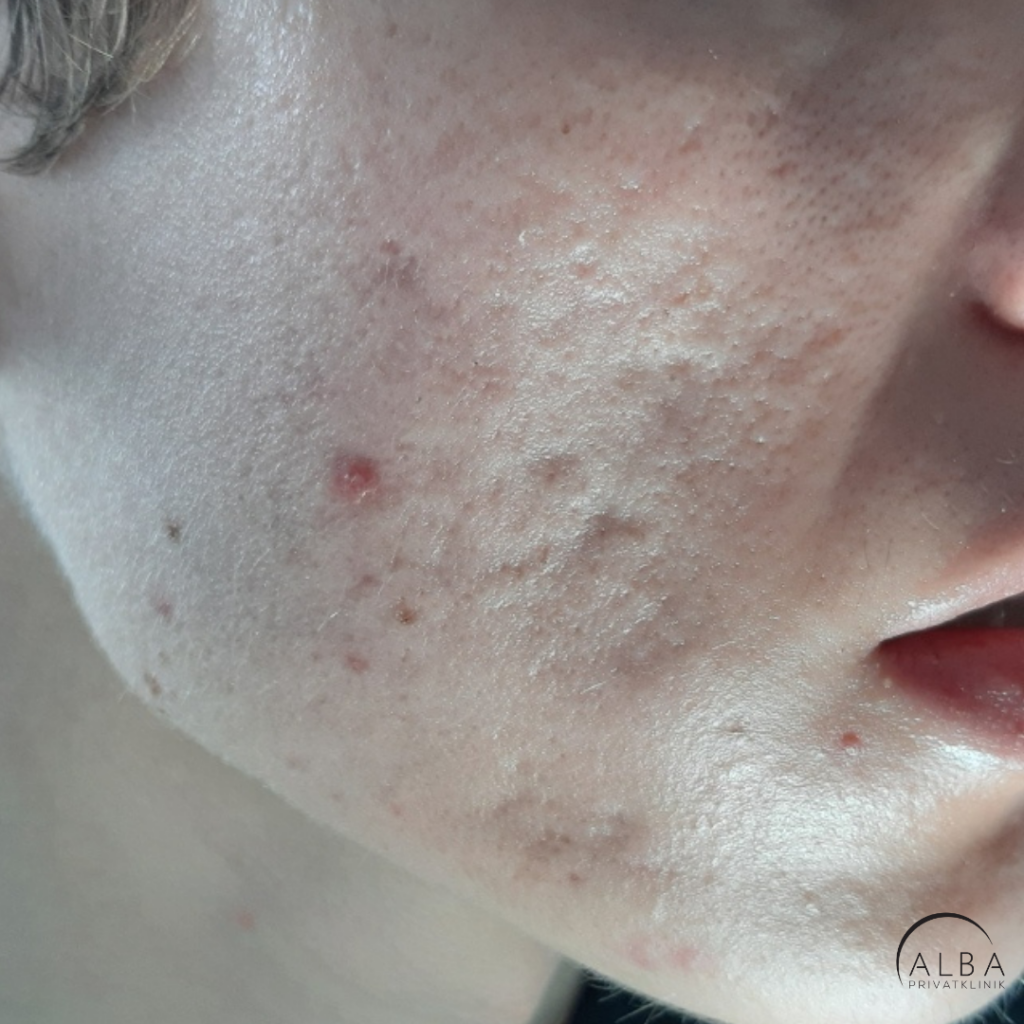
Rolling scars occur from dermal tethering of otherwise relatively normal-appearing skin and are usually wider than 4 to 5 mm. Abnormal fibrous anchoring of the dermis to the subcutis leads to superficial shadowing and a rolling or undulating appearance to the overlying skin.
Ice pick Scars

Ice pick scars are narrow (<2 mm), deep, sharply marginated epithelial tracts that extend vertically to the deep dermis or fat tissue.
The key to success
Acne has a prevalence of over 90% among adolescents and may persist into adulthood in approximately 1 in 8 patients with psychological and social implications. The commonest affected areas include the face, back, and chest because these areas have a high concentration of oil glands.
The prevalence of acne scarring in the general population is estimated to be 1-11% and might be disfiguring and life-altering.
Treating acne scars is a medical art. It requires a lot of knowledge and years of experience. I use different methods to treat different acne scars.
The best approach and the key to my success as a board-certified laser and acne scar specialist are to start every consultation with a physical examination of the skin and to identify the different acne scar types. Once the acne scar type is identified, I’m able to select the best treatment for each individual acne scar.

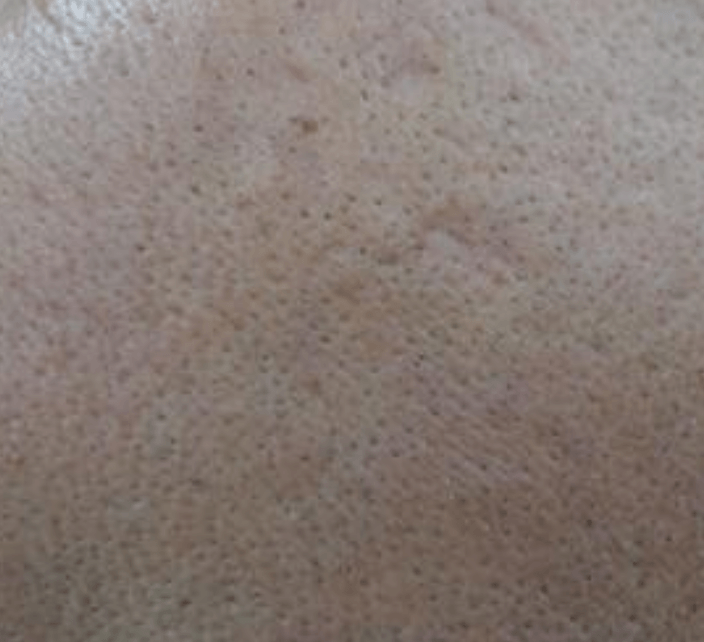
Rebuilding the skin from the ground and up
After I have done my analysis and mapping of the acne scars, I treat the deepest and most obvious acne scars first. These are the acne scars that the patients most often complain about because they catch the eyes.
When I’ve treated the deepest acne scars with techniques including subcision and TCA cross, I move on to the more superficial acne scars with other techniques including fractional lasers.
This is a stepwise process that can be done in a single treatment in mild cases of acne scarring or over several months in more severe cases to achieve the optimal result.
This treatment approach gives my patients quite superior results and is one of the reasons why patients come from most of the world to receive treatment at my clinic.
As you might hear me say a lot in this article, there are many different types of acne scars; the most common being atrophic acne scars, which are further divided into subtypes, including boxcar scars, ice pick scars, large pores, rolling scars, tethered scars, anchored scars, and linear scars.
Besides the atrophic scars, some less common acne scar types are hypertrophic scars and keloids, which again should be treated in a completely different manner than the atrophic scar types.
Now, let’s take a closer look at some of the different acne scar types and how they’re treated in my clinic.
Examination and classification of acne scars
Examination and classification of acne scars
The very first step in all my consultations of patients with acne scars is to make a thorough skin examination.
When I perform the skin examination, I analyze each individual acne scar and identify the acne scar type of each individual acne scar. I make this analysis by use of tangential lighting, and I also have the patient smile and mimic to identify any anchored or tethered acne scar.
By identifying the acne scar types, I’m able to match each acne scar with the right treatment. Since most acne scar patients have different types of acne scars, I often have to combine different treatments, including subcision, TCA cross, fractional laser, etc. This is the best way to achieve the highest success rate.
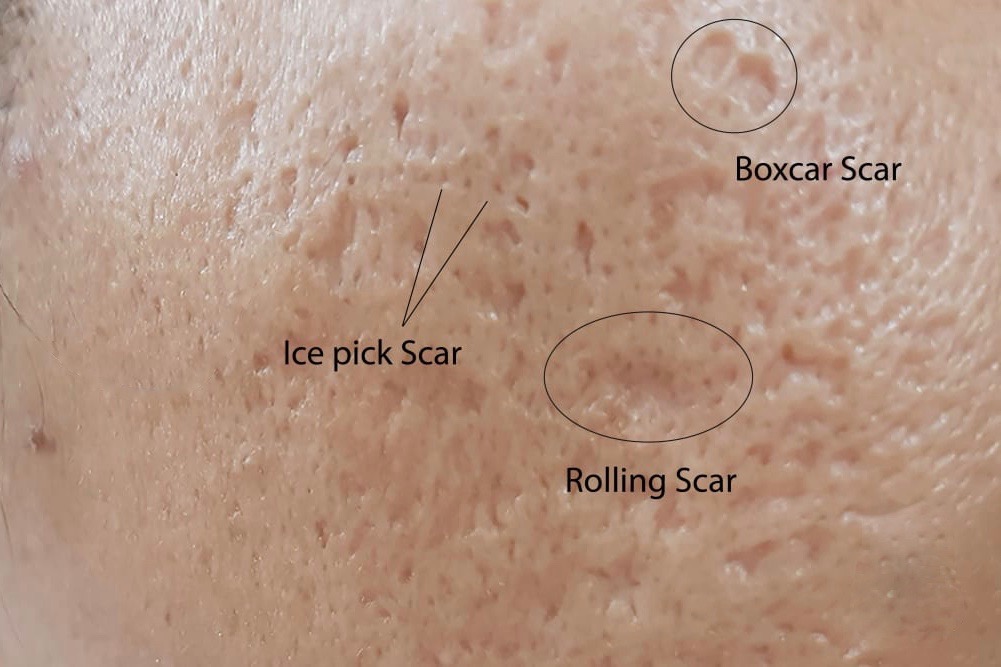

Dr. knap about The different acne scar types
By performing my skin examination, I usually find that the patient presents with different acne scar types which each have to be treated with individualized methods.
Acne scars can be divided into different acne scar types and subtypes. This is important because each individual acne scar type has certain treatments to which they respond. Hence, there is no such treatment that can be used in all acne scar types to achieve the highest cure rate.
The major groups of acne scar types and acne lesions are:
- Atrophic (deep) acne scars
- Hypertrophic (thick) acne scars
- Inflamed red acne lesions
- Hyperpigmented and hypopigmented acne lesions
Atrophic acne scars - how to identify them?
Atrophic scars are dermal depressions that generally occur as a result of collagen destruction during an inflammatory skin disease such as cystic acne, moderately and severely inflammatory acne or chickenpox.
Fibrotic bands of acne scar tissue may cause tethering of the atrophic scars, especially in Rolling scars. The fibrotic bands may pull down the scar to the underlying structures including fat tissue and muscle fascia.
Often it is the depression of the scars that form dark shadows on the skin and makes the scars visible. This might become very apparent when you are sitting with bright overhead lighting or side-lighting because the light creates defined shadows on your face.
Atrophic scars can be subclassified into different acne scar types, including ice pick scars, boxcar (box) scars, and rolling scars (Figure 1 and Table 1).

How common are Atrophic acne scars?
Atrophic acne scars are about 3-times more common than keloids and hypertrophic scars.
The prevalence of the different atrophic acne scar types are:
- ice pick scars: 60%–70%
- boxcar scar: 20%–30%
- rolling scars: 15%–25%
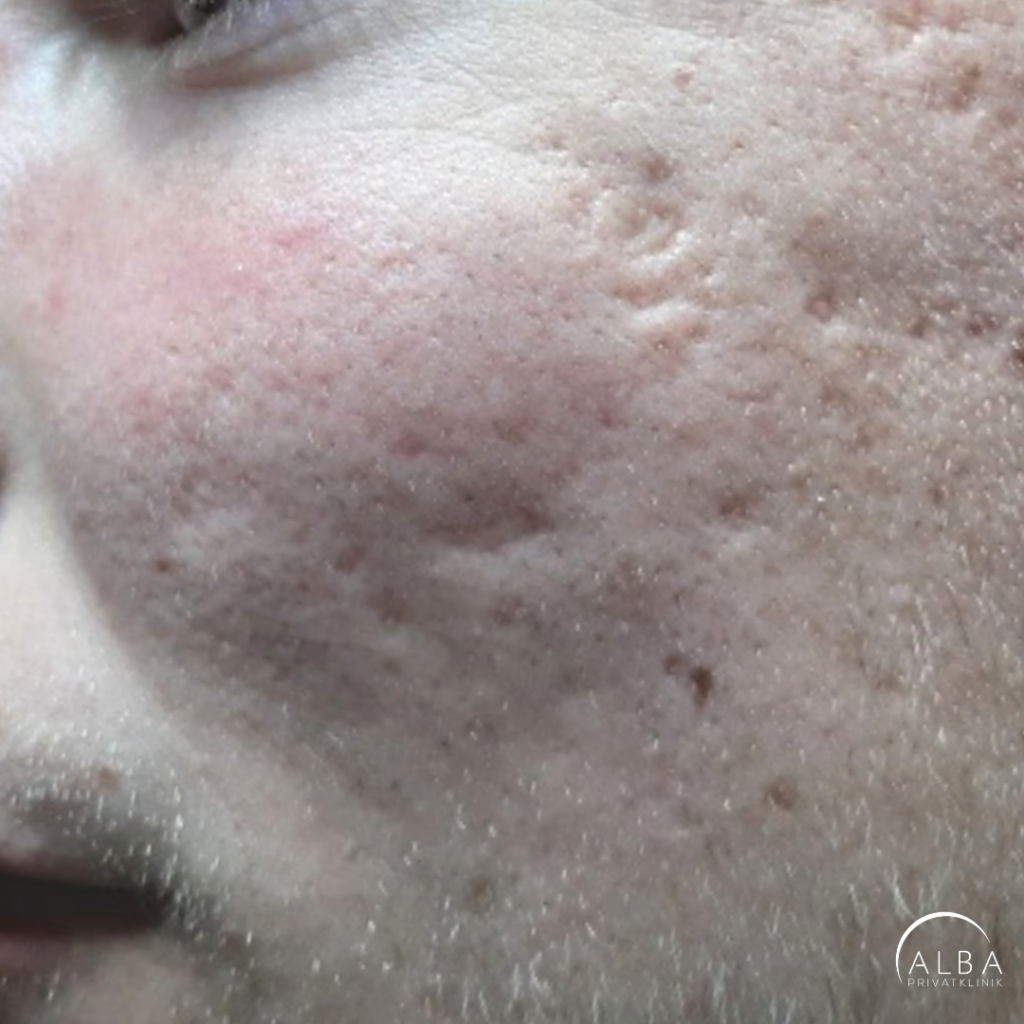
Why is it important to classify acne scars?
The subclassification of atrophic acne scars has immense importance when choosing the right treatment. E.g. rolling scars should be treated differently than boxcar scars, and likewise, ice pick scars should be treated with other methods than boxcar scars and rolling scars.
Some of my patients only have one acne scars types, while others might have all three types of acne, including ice pick scars, boxcar scar, and rolling scars. Matching the acne scar type with the right method gives me the highest cure rate of the acne scar.
Scar severity is another important factor in the management of scars. There are different tools to grade acne scar severity. Basically, the severity can be graded based on the table below:

In other words, there’s no standard treatment. I tailor an individualized acne scar revision program for each individual patient which corresponds to the type of acne and the severity of the patient’s acne scarring (see below, Part 2: Treatment of acne scars).
How to get rid of atrophic acne scars?
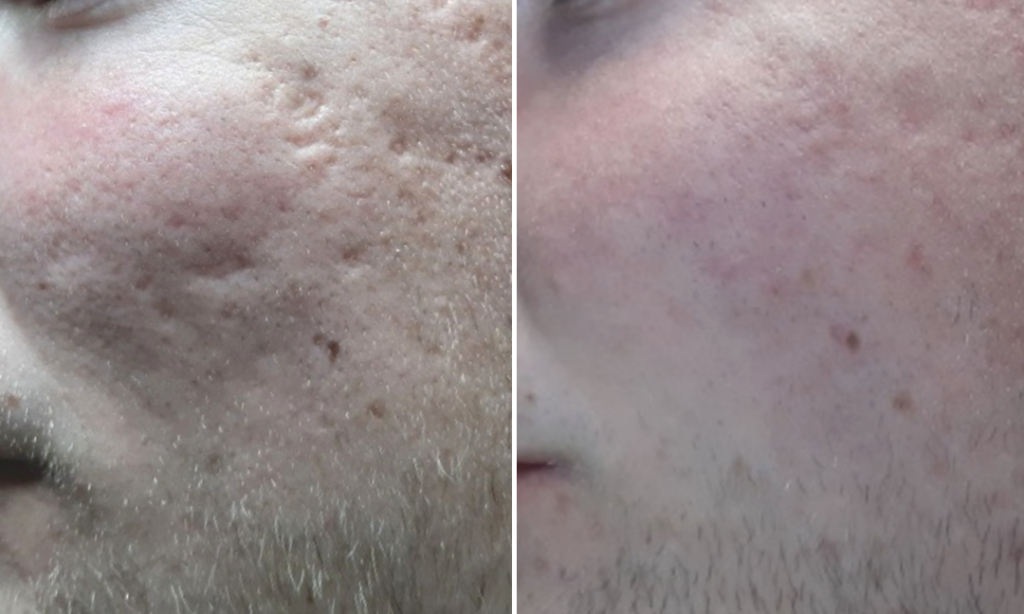
How to get rid of atrophic acne scars?
In my practice, a large percentage of all patients I see have acne scars. During the years, I have developed a certain approach that is unique and gives a high cure rate of acne scars.
The first step in any consultation is to analyze the acne scars – as described above. When I have analyzed the acne scars and identified the different acne scar types of each individual acne scar of the patient, mapping and photographing of the acne scars is done.
Thereafter, I do the planning and tailor an individualized acne scar revision program to the patient based upon my analysis, the acne scar types, severity of the scars, and skin type of the patient.
Treatment of the acne scars depends on the acne scar type, and each acne scar type can be treated with certain methods.
Treatment of ice pick scars
Ice pick scars are the most frequent form of atrophic acne scars. These are narrow (<2 mm), deep, sharply marginated epithelial tracts that extend vertically to the deep dermis or fat tissue. The picture here shows an example of ice pick scars.

There are only a few methods that effectively treat this form of acne scars. Lasers aren’t one of them!
Instead, I use different methods that specifically target each individual ice pick scar. This can be done with a technique called TCA cross, or punch excision.

TCA cross: How to treat ice pick scars?
One of the methods I do the most in my practice is TCA cross. TCA cross stands for TriChloroacetic Acid Chemical reconstitution of Skin Scars. This treatment is performed by applying a tiny droplet of TCA in the bottom of the ice pick scar. The delivery system can be as simple as a toothpick which has been dipped into a jar of TCA.
Immediately after the application of the acid in the acne scar, local tissue damage occurs, which breaks down the scar tissue, denatures
One of the methods I do the most in my practice is TCA cross. TCA cross stands for TriChloroacetic Acid Chemical reconstitution of Skin Scars. This treatment is performed by applying a tiny droplet of TCA in the bottom of the ice pick scar. The delivery system can be as simple as a toothpick which has been dipped into a jar of TCA.
Immediately after the application of the acid in the acne scar, local tissue damage occurs, which breaks down the scar tissue, denatures
the collagen and stimulates the tissue to start remodeling. The remodeling process begins immediately after the treatment through the stimulation of fibroblasts in the dermis, which creates new collagens and raises the scar.
Several acne scars can be treated in the same session, and the treatment is repeated after 4 to 6 weeks.
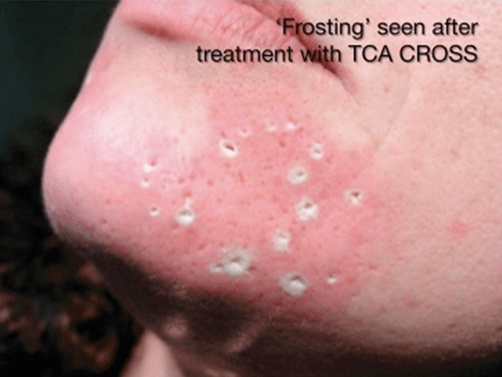
This is an incredibly effective and safe method for treating ice pick scars and narrow boxcar scars.
With each treatment, the scars improve 20-30%. Hence, after 3 treatments an improvement of 60-80 % can be expected when treating deep ice pick scars, boxcar scars or larger pores.
Most patients need 2-4 treatments with 4 weeks’ interval. The number of treatments is individual and depends on how good you heal, your acne scar type, how deep the scars are, and your skin color. In darker skin types, an additional 1-2 treatments with TCA cross should be expected, since the TCA concentration I use is weaker to reduce the risk of PIH (post-inflammatory hyperpigmentation).
Treatment of acne scars with punch excision and surgery
Another treatment I use for ice pick scars, especially if the ice pick scars are very deep or the patient has other acne scar types that can be treated in the same session with the same method, is surgical acne scar revision or punch excision.
Punch excision is performed in local anesthesia, so the treatment is painless. I use a surgical knife to excise the fibrotic scar tissue. Thereafter, the wound is closed by sutures which should be removed after approximately 6 days when the wound has closed.
To smoothen out the skin and the surgical scar, fractional CO2 laser should be performed after 3-4 weeks after the excision.
The before and after pictures below show the outcome after punch excision of several boxcar scars and TCA cross of several ice pick scars. Further improvement can be achieved in this patient with fractional lasers.


How to get rid of rolling acne scars
Rolling scars usually have a lot of abnormal fibrous anchoring of the dermis to the subcutis leads to superficial shadowing and a rolling or undulating appearance to the overlying skin. Besides, loss of collagens and elastins might also lead to some depression of the scar.
I have had a lot of patients coming to me and say that they have had multiple laser treatments performed by other doctors and say to me that none of these laser treatments worked. The reason why is that laser treatments usually don’t work very well on the tethering that lies deep underneath the skin.
Hence, the first step when treating tethered rolling scars is to break the tethering with other methods. When this has been done, further improvement of atrophic rolling scars can be achieved with a fractional CO2 laser or other energy-based devices.


Subcision: Treatment of tethered acne scars
To break the tethers that pulls down most rolling scars and causes the rolling or undulating appearance to the overlying skin, I use a technique called subcision. Local anesthetic agents are applied to reduce procedure-related pain.
Subcision (also called subcutaneous incisional surgery) is the absolutely most effective treatment for rolling scars and other tethered and anchored scars, where the problem lies deep underneath the skin.
Subcision is a non-operative technique that involves a needle being inserted subcutaneously.
By moving the needle parallel to the skin surface in a fanning motion the fibrous strands are untethered within the scar. The fibrotic bands cannot be treated with any other methods. Hence, lasers won’t work on these types of acne scars.
Once I untether the fibrous strands within the scar with the Nokor needle, the skin scar is immediately released and the skin scar is elevated. Hence, subcision gives immediate improvement.
To avoid new tethers in the months after the procedure, I use a dermal filler to inject into the cavity underneath the scar immediately after subcision.
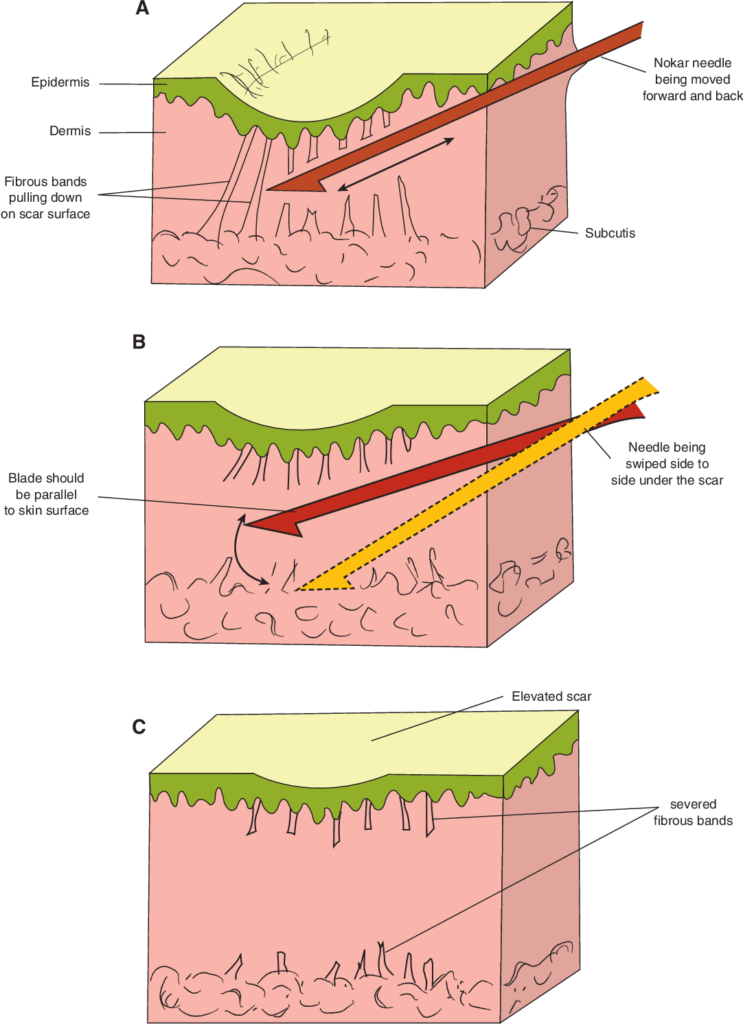
The dermal filler works as a buffer and replaces any volume loss caused by acne.
Besides, untethering the fibrous strands subcision also stimulates new connective tissue formation that will help elevate the depressed surface of scars.
Depending on the scar severity, subcision typically has to be performed between 1-3 times to get the optimal outcome.
The principle of subcision is illustrated in the figure.
Once, the subcision and dermal filler injection have been done, further improvement of the skin texture can be achieved by other methods such as fractional laser, micro-needling, and other devices.
How to treat boxcar scars?
Boxcar scars are the second most frequent form of atrophic acne scars. They usually have sharply demarcated vertical edges, similar to varicella (chickenpox) scars, and clinically they are wider at the surface than ice pick scars and do not taper to a point at the base.
The picture shows an example of boxcar (box) scars.
This type of acne scar can be treated in a number of different ways either by replacing the volume loss or simply excising the scar with punch excision.
In most cases, I prefer treating boxcar scars with a fractional CO2 laser, but other methods can also be used in certain types of boxcar scars, including micro-needling, TCA cross, dermal filling, and surgical excision.

Fractional lasers: How to treat acne scars with fractional CO2-laser?
Fractional CO2 laser skin resurfacing is an internationally recognized technique to improve acne scars and my preferred laser for acne scar revision because of its power and ability to remodel and enhance certain acne scar types.
Fractional laser is the perfect treatment for shallow boxcar scars and other acne scar types (including rolling scars following subcision).
In fractional laser skin resurfacing, a device called a fractional laser delivers precise microbeams of laser light into the lower layers of the skin, creating deep, narrow columns of tissue coagulation. Coagulated tissue in the treatment area stimulates a natural healing process that results in fast growth of healthy new tissue. Hence, when treating acne scars, the scar tissue is broken down via controlled damage. Fibroblast in the deeper dermis thereafter starts creating new collagens and the acne scars are remodeled.
As the name suggests a fractional laser only treats part of the skin. Thus, when performing fractional laser resurfacing of acne scars, the laser removes layers of skin tissue in a fractionated method; i.e. columns of skin are removed, leaving the skin surrounding each column intact to aid in healing. This gives fewer side effects and much faster skin healing.
Fractional laser resurfacing is an in-office, non-invasive treatment that requires pre and post-treatment medications to ensure proper healing and comfort during the procedure.
There are different types of fractionated lasers and some lasers are much more powerful than others. The more power a laser delivers, the higher the effect, the more remodeling of the skin, the better the outcome of the acne scar treatment.
The figure below shows the difference between fully ablative resurfacing (left-side figure), non-ablative fractional resurfacing such as a Fraxel laser (in the middle), and ablative fractional resurfacing such as fractional CO2 laser (right-side figure):
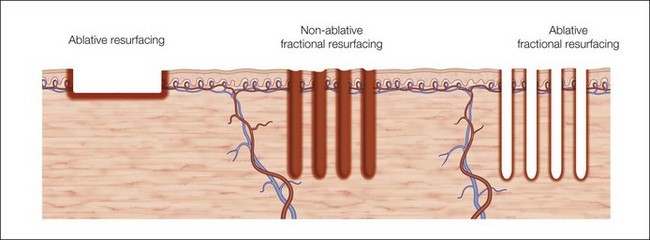
However, fractional laser resurfacing is usually not my first treatment of choice. Since most of my patients have several different acne scar types, including both ice pick scars, boxcar scars, rolling scars, tethered scars, and anchored scars, the highest cure rate is to match each individual acne scar types with the right method.
My approach is to start with the deepest and most obvious acne scars. This typically involves subcision, dermal filling, and TCA cross and/or surgical revision before continuing with fractional laser resurfacing or other methods for general improvement of the skin texture.
The benefits of Micro-needling?
Fractional skin resurfacing can also be achieved with other methods such as micro needling with a dermapen or a dermaroller. However, in my eyes, micro needling is only relevant in patients with shallow acne scars, since much more powerful methods exist, including treatment with fractional lasers.
However, the benefits of microneedling are that it can be combined with different serums and plasma-rich plasma which enhances the healing and remodeling after microneedling and other procedures that are performed during an acne scar revision program.
What are Hypertrophic acne scars and keloids?
Hypertrophic scars are typically raised and firm scars that remain within the borders of the original site of injury. These kinds of acne scars are less common than atrophic acne scars. In contrary to atrophic scars, the hypertrophic scars develop as a result of too much deposit of collagens during the wound healing following acne.
Keloid scars are reddish-purple papules and nodules that extend beyond the borders of the original wound. Keloids are only seen in a few patients.

How to get rid of Hypertrophic acne scars and keloids?
Hypertrophic acne scars and keloids often have to be treated with a combination of different techniques, including surgery, lasers, intralesional injections, and silicone gel sheeting, to achieve a good result.
The recurrence rate though is high in these types of acne scars, particularly in keloids because the main problem is that the patient produces too much collagen during wound healing. Hence, every approach should have this in mind, and try to avoid the uncontrolled production of collagen.
What are inflamed red, hyperpigmented and hypopigmented acne lesions?
These scars can be erythematous, hyper- or hypopigmented flat marks which persist as a discoloration in the skin. They do not represent a problem of contour like other scar types but of color.
In isolation, red acne lesions are flat, macular lesions that are seen in the first weeks up to months after having active acne lesions. The redness is caused by inflammation and vasodilatation.
The best thing about the inflamed red acne lesions is, that they don’t necessarily cause atrophic or hypertrophic scarring and that the inflamed red acne lesions are relatively easy to treat with a vascular laser.
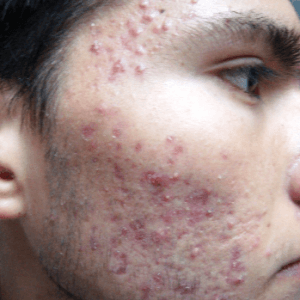
Treatment of the inflamed red acne lesion
Treatment of the inflamed red acne lesion
Treating inflamed acne and red acne lesions is an easy task, which can be done with a vascular laser or intense pulse light (IPL).
During the wound healing which follows acne, new blood vessels cause the lesions to become red. The lasers target the red vessels in the lesions, which closes the vessels. This removed the red color.
Treatment of the hyperpigmented acne lesions
Post-inflammatory hyperpigmentation (PIH) is caused when pigment is produced during the inflammation of acne. This is a temporary darkening locally in the scar that will typically last for a few months. PIH should be expected in darker skin types.
To improve the skin healing process and lower the risk of PIH, I always recommend my patients to:
- Use a fading cream starting on day 7 after the treatment.
- Use a high factor (SPF 50) sun blocker two times a day starting at day 7 before the treatment and again at day 7 after the treatment for 3 months
- Sun avoidance in the months after the treatment.
Remember that you’re always allowed to use a recovery makeup (e.g. Lycogel) or similar products to cover any PIH as long as the darkening persists.
Treatment of the hyperpigmented acne lesions
Dr. Knap’s approach to acne scar revision
What makes my approach unique?
My very first step in any acne scar consultation is to analyze the skin of my patient.
I use tangential lighting when I analyze the acne scars since this creates shadows that present the correct depths of the scars. I’d also have to see the patient smile and mimic to identify any tethering and anchored scars that would have to be untethered by use of subcision.
Touching the skin is also an important part of the acne scar analysis to identify how deep the fibrosis lies.
Hence, this is a 3-dimensional skin analysis and the most important step that make the foundation for the following planning of the acne scar revision program. Hence, this cannot be performed over the phone or by sending photographs via email to my office.
When I have identified the acne scar type of each individual acne scar, mapping and photographing of the scars are performed. Thereafter, I tailor an acne scar revision program together with the patient.
Bear in mind that no single treatment is ideal for all acne scar types. Hence, matching each acne scar with the right treatment is the key to my success as a laser and acne scar specialist.
I always treat each individual acne scar with the types of methods that I believe give the highest success rate starting with the deepest acne scars.
These acne scars include atrophic acne scar types including ice pick scars, boxcar scars, rolling scars, anchored scars, tethered scars, and linear scars. Repairing the skin from the ground and up makes good sense. Thus, the deepest acne scars, such as deep ice pick scars, should not be treated with a fractional laser at first, but rather techniques that specifically target the very depths of these types of scars, e.g. TCA cross or punch excision. When the deepest acne scars have been raised to a certain depth, the general skin texture can be improved by lasers.
An acne scar revision program might last between 4-13 months and on average 8 months depending on the acne scar types, the severity of the scars and the skin type of the patient.
In this article, I have described some of my techniques. However, this is only a general overview and doesn’t illuminate the complexity and variations in the acne scar revision program, which I tailor for each individual patient to achieve the highest cure rate.
Best Regards

Ulrik Knap, MD., Laser & Acne scar specialist

